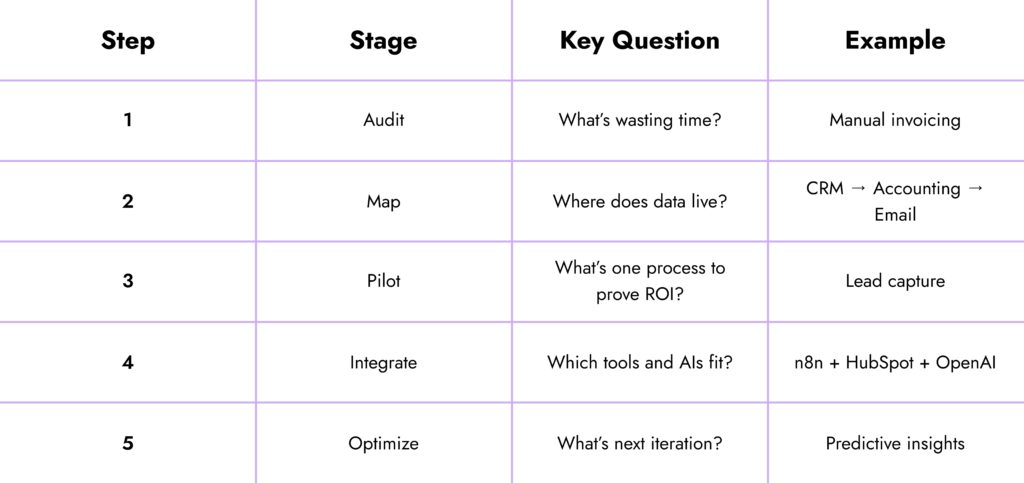A New Era of Business Efficiency

Not long ago, “process automation” sounded like something only massive corporations could afford – the kind of efficiency reserved for boardrooms filled with consultants and enterprise software.
Today, that’s changed. Automation has become the great equalizer. With tools like Zapier, Make, n8n, and even custom-built AI workflows, small and mid-size businesses are now tapping into capabilities once reserved for global giants.
And that’s where the real magic happens.
At Digilite, we’ve seen firsthand how the right automation – implemented thoughtfully – can redefine how a business runs. It’s not about replacing people. It’s about re-engineering the way work gets done so your people can focus on what matters most: relationships, creativity, and growth.
Looking Back: Every Revolution Starts With Process

To understand where automation is taking us, it helps to look back. In the early 20th century, Henry Ford revolutionized manufacturing with the assembly line. It wasn’t just about cars – it was about process design. Every movement, every role, every minute was re-imagined to produce something faster and better.
Decades later, computers entered the scene and businesses experienced another leap. Repetitive paper tasks were digitized. Emails replaced memos. Accounting systems replaced ledger books. That was the first wave of digital automation.
Then came the cloud – and with it, a new kind of flexibility. We could now access data, workflows, and teams from anywhere. When the world shut down during COVID-19, this became the difference between surviving and collapsing.
And that’s when automation truly proved its worth.
When Everything Changed: COVID-19 and the Rise of the Automated Business
When the world locked down in 2020, companies had two options: pause or pivot.
At Digilite, we made our choice early. We transitioned our global team into a fully remote operation almost overnight. We automated project tracking, task assignments, time logging, and performance KPIs across multiple offices – including our Yerevan branch – ensuring every client deliverable stayed on track despite the chaos.
The lesson? Automation wasn’t just a technical upgrade. It became a survival strategy.
That period taught us something fundamental:
Businesses that had already digitized and automated even small parts of their workflow – CRMs, billing systems, marketing pipelines – bounced back faster. Those who hadn’t were left scrambling to catch up.
Automation had quietly evolved from a “nice to have” to an existential advantage.
Where We Are Now: The Connected Business
Fast forward to today, and we’re in the middle of a new revolution.
The lines between software categories are blurring – and everything is connected.
Your CRM talks to your accounting software.
Your e-commerce platform updates your inventory in real time.
Your customer support chats feed into your analytics dashboard.
And all of it can be orchestrated by AI.
This is what we call the Connected Business – a system of apps, APIs, and automation tools working together to create an invisible digital backbone for your operations.
At Digilite, we’ve helped companies in every sector – from e-commerce and professional services to manufacturing and real estate – design these connected ecosystems. And the results speak for themselves:
- Faster decision-making.
- Lower operational costs.
- Happier clients and teams.
The beauty of automation today is that you no longer need an enterprise budget to achieve enterprise-level efficiency.
Zapier vs. n8n vs. Custom Automation: Finding the Right Fit
Let’s break down the modern automation toolkit.

1. Zapier: The Gateway Drug to Automation
Zapier is like the “training wheels” of automation – easy to use, fast to deploy, and surprisingly powerful. It connects over 7,000 apps, from CRMs and email tools to accounting platforms and chatbots.
If your goal is to eliminate repetitive tasks – say, adding new Shopify orders to QuickBooks or sending a Slack message when a new lead fills out a form – Zapier can handle it in minutes.
The upside: speed and simplicity.
The downside: it can get expensive as workflows scale, and you’re limited by pre-built integrations.
2. n8n: The Open-Source Powerhouse
For businesses ready to get serious, n8n is a game changer. Think of it as Zapier’s more flexible, cost-efficient cousin. It’s open source, which means you can host it on your own server (we often use DigitalOcean for this at Digilite).
You can customize workflows, integrate with any API, and even build hybrid human-in-the-loop systems – where AI drafts something, and a human reviews and approves it.
We use n8n extensively in our internal automation platform called DigiFlow, which powers much of our marketing and content automation. It connects OpenAI, HubSpot, SendGrid, and SocialPilot – orchestrating dozens of micro-workflows that would otherwise require entire departments.
The result? Fewer bottlenecks, faster campaigns, and smarter reporting.
3. Custom Automation: The Deep Integration Layer
When your business relies on multiple systems that must work seamlessly – like a CRM, accounting suite, inventory tracker, and quoting engine – custom automation becomes the most strategic investment you can make.
We’ve built custom workflows that sync WordPress forms with HubSpot, trigger AI-generated responses, create leads, and assign them to account managers based on scoring models. We’ve connected Shopify stores to ERP systems, automating everything from stock updates to shipping notifications.
The benefit here isn’t just efficiency – it’s data integrity.
When your tools talk to each other perfectly, you eliminate the human error that costs companies thousands every month.
Automation Platform Comparison: Zapier vs. n8n vs. Custom Automation
| Feature / Criteria | Zapier | n8n (Open Source) | Custom Automation (Built by Digilite) |
| Best For | Small teams and startups that want quick wins | Growing businesses seeking flexibility and control | Established companies needing deep integrations and scalability |
| Hosting | Cloud (Zapier servers) | Self-hosted or cloud (e.g., DigitalOcean) | Fully owned and hosted within client’s infrastructure |
| Setup Speed | ⭐⭐⭐⭐ – Plug & play | ⭐⭐⭐ – Requires light technical setup | ⭐⭐ – Requires planning and development |
| Ease of Use | Drag-and-drop, no code | Low code with visual builder | Depends on scope; Digilite handles complexity |
| Integration Library | 7,000+ pre-built apps | 300+ nodes + any API | Unlimited – anything with an API or database |
| Scalability | Moderate – can get costly with high volume | High – runs on your own resources | Enterprise-grade – built for performance and growth |
| Monthly Cost | Starts free → typically $50–$200+ per user/month | Self-hosted: $0–$50/month(server + setup) | Variable – custom quote based on project scope |
| Ownership of Data | Limited – stored on Zapier’s servers | Full control (your infrastructure) | Complete ownership (fully private) |
| Security & Compliance | SOC 2 compliant but shared environment | Depends on host; can meet SOC 2 if configured | Fully compliant with your org’s policies |
| AI Integration | Basic via OpenAI / ChatGPT connectors | Full flexibility – integrate any LLM or API | Deep integration – multi-agent workflows, private RAG, etc. |
| Customization Level | Low – prebuilt “Zaps” | Medium – extend with code nodes | Very High – bespoke logic and orchestration |
| Example Use Case | Automate CRM → Email → Slack notifications | Multi-step marketing workflows across CRM + ERP | Company-wide process automation with AI insight layer |
| Maintenance | Minimal | Moderate (requires monitoring) | Managed by Digilite (ongoing support) |
| ROI Payback Period | 1–3 months | 3–6 months | 6–12 months, with exponential long-term returns |
| Ideal Budget Range | $2K–$5K annually | $5K–$10K annually | $15K–$50K+ annually (project-based) |
How AI Is Supercharging Automation
Automation used to be rule-based.
Now it’s intelligence-based.
AI isn’t just doing tasks – it’s making decisions.
Imagine this: a lead comes in through your website. Instead of just sending it to sales, your AI checks the company size, LinkedIn data, and historical patterns from your CRM. It then assigns a score and routes it to the right salesperson – even generating the first outreach email automatically.
That’s not science fiction. That’s what AI-driven automation looks like in 2025.
At Digilite, we’ve begun embedding AI into nearly every automation we deploy.
From predictive analytics in marketing campaigns, to AI chatbots that qualify leads before they ever reach a human – we’re turning business systems into living, adaptive organisms.
The end goal? A self-optimizing business.
Real Stories: Automation in Action
Let’s look at a few real-world examples (names anonymized for confidentiality).

Case Study #1: The Manufacturing Client
A mid-sized manufacturing firm was manually managing RFQs (Requests for Quotes). Each request required five emails, three spreadsheets, and a lot of back-and-forth.
We built a system that connected their website forms with their CRM and quoting tool. Every new RFQ now automatically creates a record, assigns it to the right manager, and notifies the production team.
What used to take 3 days now happens in under 15 minutes.
Result: 60% faster turnaround and zero lost opportunities.
Case Study #2: The Real Estate Brokerage
A brokerage partner was juggling leads from multiple sources – website forms, Facebook ads, and realtor networks – all manually tracked in spreadsheets.
Our team implemented an n8n-powered system that centralized all leads in HubSpot, enriched them with market data, and automatically assigned them to agents based on zip code and performance.
The automation not only improved conversion rates by 35%, but also gave management real-time visibility into performance dashboards.
Case Study #3: The Digital Agency
Yes, even our own industry.
Digilite’s internal content team was spending hours scheduling posts, writing captions, and tracking engagement. With DigiFlow, our AI-powered content automation platform, we now generate and schedule content across multiple brands automatically – with human review only where creativity matters.
The time saved? Roughly 40 hours per week.
The ROI? Immeasurable.
The Human Element: Automation Is Not About Replacing People
Here’s a truth we don’t talk about enough:
Automation doesn’t replace humans – it amplifies them.
The goal is not to eliminate jobs, but to eliminate waste – the repetitive, error-prone, low-value tasks that drain creativity and morale.

Your team should be thinking, strategizing, designing, selling – not copying data between apps or chasing overdue invoices. That’s what automation is for.
When you automate the mundane, you give your people the space to do the meaningful.
And in the end, that’s what drives real business growth.
The Economics of Automation: The Hidden ROI

Many business leaders hesitate when they hear the word “automation” because it sounds expensive.
But let’s look at the numbers.
Say you have five employees spending one hour a day on repetitive admin work. That’s 25 hours per week. Even at a modest $30/hour, that’s $39,000 per year spent on tasks a simple automation could handle for a fraction of the cost.
Now multiply that by every team and department in your organization.
Automation isn’t a cost – it’s a multiplier.
It compounds efficiency, accuracy, and speed in ways that are hard to measure until you’ve experienced it.
At Digilite, we’ve seen clients achieve ROI in as little as 30 days after implementation.
A Framework for Getting Started
If you’re considering automating your business, here’s a simple framework we use with our clients:
- Audit Your Processes
Identify repetitive, time-consuming tasks. Ask your team, “What’s one thing you do every week that drives you crazy?” That’s your starting point. - Map the Data Flow
Understand how information moves through your business – from marketing to sales to fulfillment to finance. This is where inefficiencies hide. - Start Small
Don’t try to automate everything at once. Pick one workflow – like lead capture or invoicing – and prove the value. - Choose the Right Tools
Decide whether you need plug-and-play (Zapier), flexible open-source (n8n), or custom (Digilite-built) automation. - Integrate AI Where It Matters
Use AI for pattern recognition, personalization, and decision support – not just for automation’s sake. - Monitor and Iterate
Automation is never “set and forget.” Measure, refine, and keep evolving.

The Future: Autonomous Business Systems
We’re entering an era where businesses will increasingly operate autonomously.
Imagine a company where:
- AI predicts cash flow issues before they happen.
- Marketing adjusts campaigns in real time based on performance data.
- Customer service chatbots solve 80% of inquiries instantly.
- Hiring systems recommend candidates who best fit your culture.
That’s not decades away. It’s happening now.
The question is: will your business adapt fast enough to keep up?
A Personal Note
As someone who’s spent over 15 years helping businesses scale through technology, I can tell you this with confidence – the companies that embrace automation early don’t just grow faster, they lead markets.
The difference between a company that survives and one that thrives is often not innovation itself – it’s adoption.
At Digilite, our mission has always been simple: to help businesses evolve. Whether that’s through AI, automation, or custom development, our goal is to connect your systems, your people, and your purpose.
Because in the end, technology is not about replacing humans.
It’s about giving humans more time to be human.

Ready to Build Your Automated Future?
If your business is ready to take the leap – whether it’s automating a single process or building a fully integrated AI-driven system – our team at Digilite can help.
We’ve built automation ecosystems for companies across industries and continents.
And we can help you design one that fits your business perfectly – from strategy to execution.
👉 Let’s start the conversation.
Visit Digilite.ca or reach out directly to our team to see how automation can transform the way you work.
Take a moment to check our Automation Savings Calculator to estimate your potential time and cost savings — and discover how process automation and AI can help your team work smarter, not harder.
Automation Savings Calculator
Estimate ROI from labor savings, fewer errors, and conversion lift. All numbers are editable.
Quick presets
Team & Time
Quality (Error Reduction)
Growth (Conversion Lift)
Costs
Results (Annualized)
Estimates only. Book a discovery call for a tailored ROI model.




